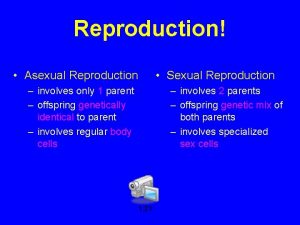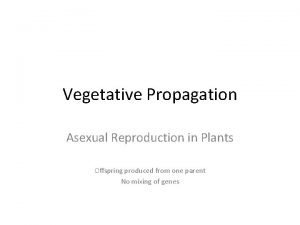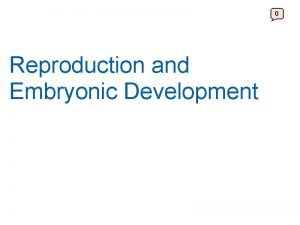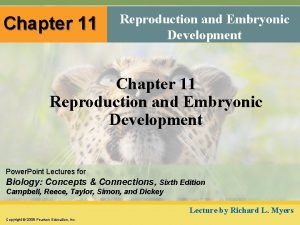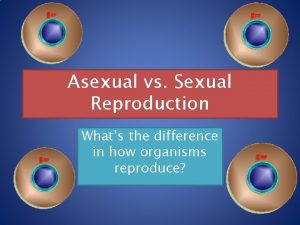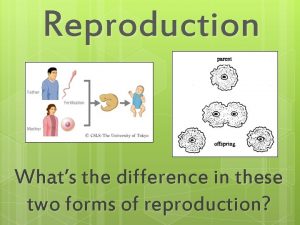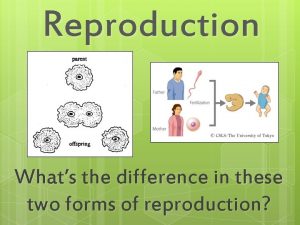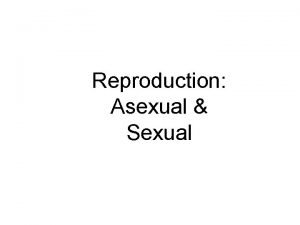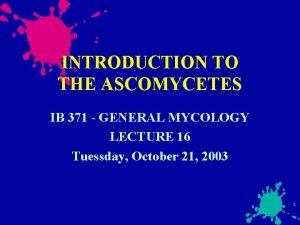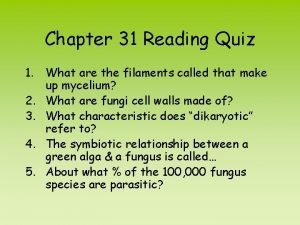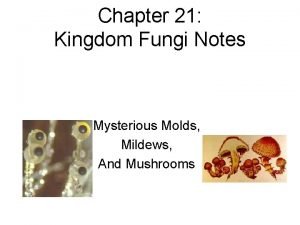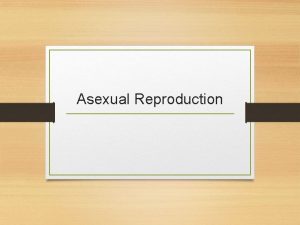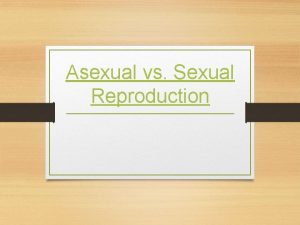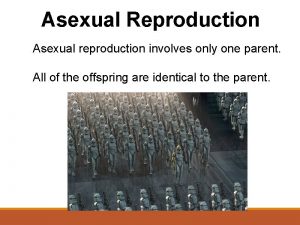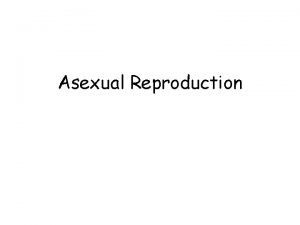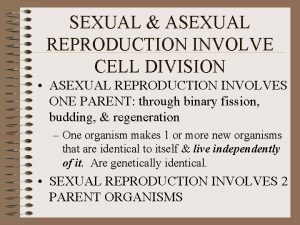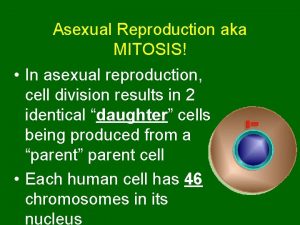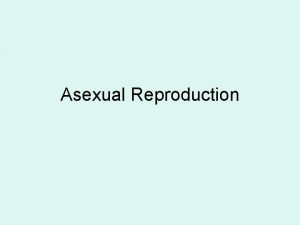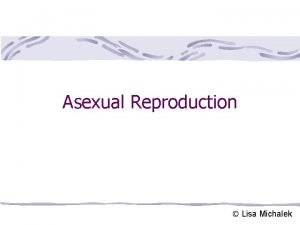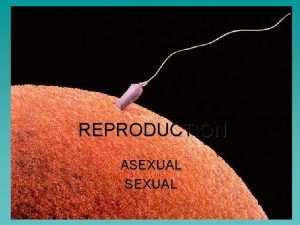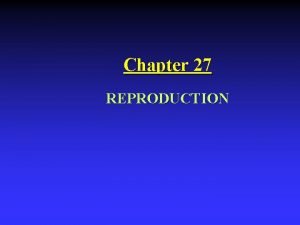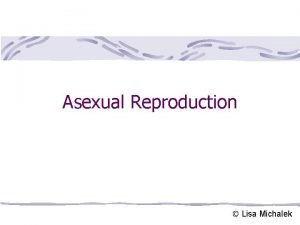The Cell Cycle 1 Reproduction Asexual Reproduction Involves



























- Slides: 27

The Cell Cycle 1

Reproduction • Asexual Reproduction: – Involves only 1 organism – New individual is genetically identical to parent-clone • Single celled organisms – - binary fission: cell divides in 2 2

Multicelled organisms: • Budding • Plant propagation • Parthenogenesis 3

Reproduction • Sexual Reproduction: – Involves 2 parental organisms – New individual is different from either parent – Leads to greater genetic diversity 4

• Sexual Reproduction: 5

Chromosome Structure • Chromatin: DNA and protein in long, thin thread-like, invisible form 6

Chromosome Structure • Chromosomes: Condensed chromatin that appear right before cell division – Sister chromatids- contain exact copies of DNA– Centromere- protein “button” holds chromatids together 7

Chromosome Structure 8

The Cell Cycle • The time it takes from 1 cell division to the next • Varies in length of time depending on cell type 9

The Cell Cycle • Function -asexual reproduction – Single celled organisms -produce new individuals– Multicelled organisms – • Growth -increase in size by increasing in cell number • Tissue replacement and repair 10

The Cell Cycle Two alternating periods 1. Interphase- growth 2. Mitosis- division Interphase Growth Division Mitosis 11

Phases of the Cell Cycle 12

The Cell Cycle Interphase: • • The growth period. Longest phase of the cell cycle Cell spends 98% of time in interphase 3 stages 13

3 Stages of Interphase G 1 -1 st Gap phase: • The cell grows in size and carries on normal functions S - Synthesis phase: • DNA Replication • Chromosomes copied in preparation for cell division. G 2 - 2 nd Gap phase: • Structures needed for cell division are assembled. • No turning back- cell division will occur 14

Phases of the Cell Cycle How the Cell Cycle Works 15

The Cell Cycle • Mitosis: – The division period – Division of the nucleus – Four distinct phases. • Prophase • Metaphase • Anaphase • Telophase The Cell Cycle 16

Prophase • First phase of mitosis • Chromatin condenses and chromosomes become visible • Nuclear membrane and nucleoli disappear • Structures necessary for cell division appear – Centrioles- barrel shaped, 2 pair, each moves to opposite poles – Spindle fibers- span the two poles 17

Prophase 18

Metaphase • Chromosomes line up along the midline of the cell 19

Anaphase • Centromeres and sister chromatids separate • Spindle fibers shorten and pull chromatids, now called chromosomes, toward opposite poles 20

Telophase • Reverse of Prophase • Begins when chromosomes stop after reaching poles • Chromosomes decondense to less visible chromatin form • Nucleoli reappear • Nuclear membrane appears around each set of chromosomes 21

Telophase 22

Cytokinesis Division of the cytoplasm and organelles Results in 2 daughter cells New cells begin a new cell cycle Different for plants and animals 23

Animal Cell Cytokinesis Cleavage furrow-cell membrane pinches in Animation: Mitosis 24

Plant Cell Cytokinesis Cell plate formation- new cell wall is added to separate 2 daughter cells onion root tip 25

Control of the Cell Cycle • A series of enzymes monitor a cell’s progress from phase to phase. • A disrupted cell cycle can result in excessive cell division, or cancer 26

Skin Cancers Benign Malignant Symmetrical Asymetrical Borders are even Borders are uneven One shade Color: Two or more shades Smaller than 1/4 inch Diameter: Larger than ¼ inch 27 http: //www. skincancer. org/skin-cancer/melanoma_2. html
 Asexual reproduction involves *
Asexual reproduction involves * What type of reproduction involves only one parent
What type of reproduction involves only one parent The disadvantages of sexual reproduction
The disadvantages of sexual reproduction Asexualk
Asexualk Asexual and sexual reproduction venn diagram
Asexual and sexual reproduction venn diagram Mitosis sexual reproduction
Mitosis sexual reproduction Dahlia asexual reproduction
Dahlia asexual reproduction Types of asexual reproduction
Types of asexual reproduction Phylum nematoda segmentation
Phylum nematoda segmentation Parthenogenesis
Parthenogenesis An example of asexual reproduction
An example of asexual reproduction Asexual propagation layering
Asexual propagation layering Benefits of sexual propagation
Benefits of sexual propagation Asexual reproduction
Asexual reproduction Asexual reproduction
Asexual reproduction Whats sexual reproduction
Whats sexual reproduction Sexual example
Sexual example Chapter 19 asexual reproduction
Chapter 19 asexual reproduction Two types of reproduction
Two types of reproduction Whats a sexual reproduction
Whats a sexual reproduction Whats asexual reproduction
Whats asexual reproduction Asexual or sexual reproduction
Asexual or sexual reproduction Somatogamy in fungi
Somatogamy in fungi Chromosome number of animals
Chromosome number of animals Ascomycota asexual reproduction
Ascomycota asexual reproduction Fungi examples
Fungi examples Budding asexual reproduction
Budding asexual reproduction Asexual vs sexual reproduction venn diagram
Asexual vs sexual reproduction venn diagram

